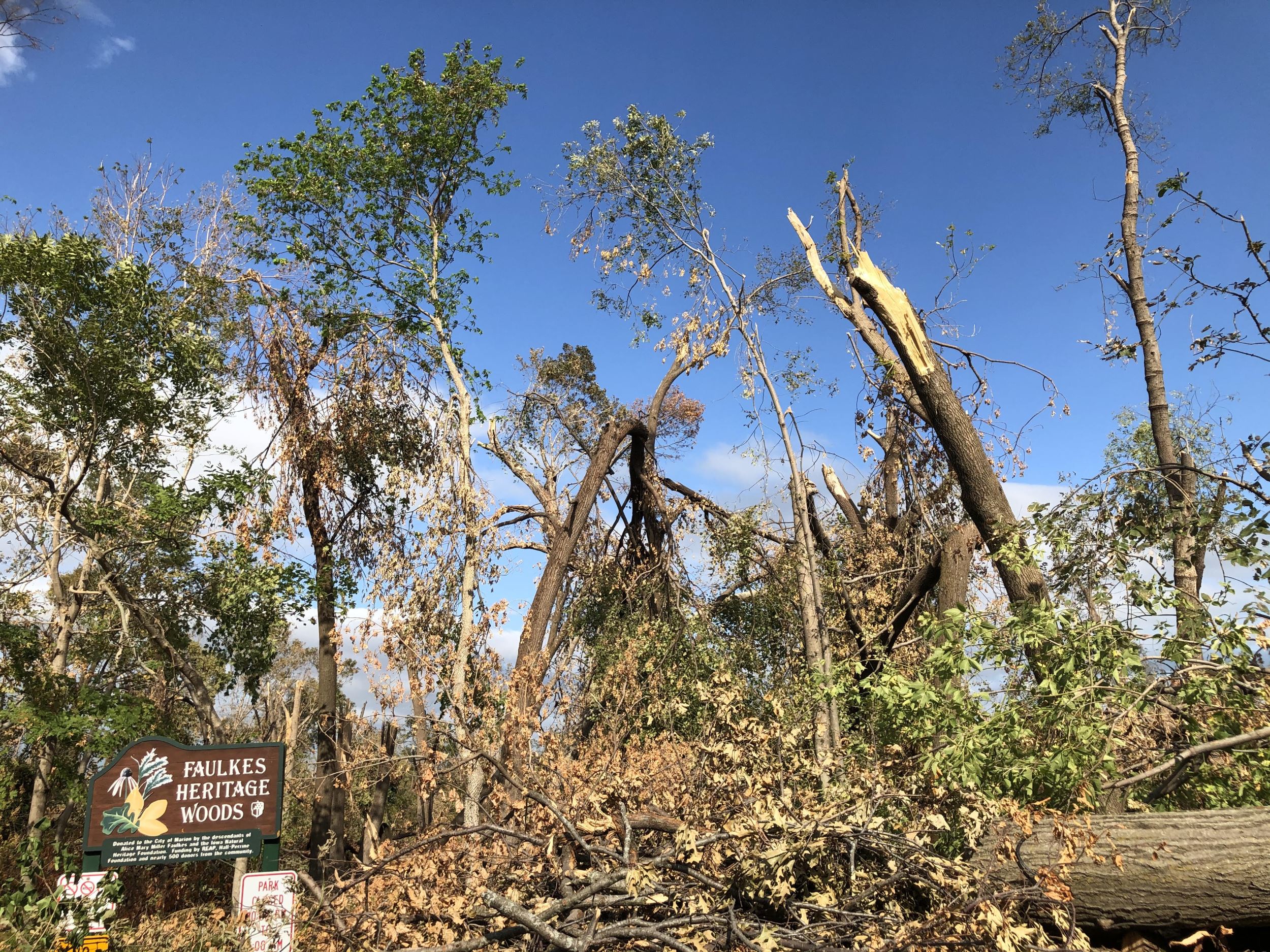August's Devastating Derecho Has a Silver Lining
By Rich Patterson, Special to INHF on September 10, 2020 in Blog

Photo by Marion Patterson
When government surveyors made their way across Iowa in the early 1800s, they observed a surprising site east of what is now Cedar Rapids. In the midst of a savanna’s massive oaks, they found an area where all the trees lay fallen facing the same direction. Almost certainly a powerful wind had toppled them.
Storms may be destructive, but nature is resilient. Over a century-and-a-half later, the area now nurtures enormous trees, some of which surely emerged in the aftermath of that storm.
The derecho that roared across Iowa on August 10, 2020, included winds that reached 140 miles an hour in some areas, clearing forests and cornfields in its path and leaving homes, barns, silos, garages and signs torn and twisted. The 40-minute storm felled 65% of Cedar Rapids’ trees and stripped leaves and branches off countless others. Many may not survive.
The derecho didn’t spare natural areas, either. My wife and I live adjacent to Faulkes Heritage Woods, owned by the City of Marion. We often walk through its 110 acres that bisect Indian Creek. Prior to the storm, ancient trees, mostly oaks, captured the sunshine, keeping the ground in perpetual shade. This suppressed understory brush made off-trail sauntering easy. Come May, we loved walking amid a magnificent diversity of ephemeral flowers while a chorus of scarlet tanagers, grosbeaks and warblers sang from trees far above us.
A few days after the derecho, we attempted to venture into Faulkes only to discover a vastly changed landscape. To reach its interior we were forced to climb over fallen trees, skirt enormous holes created by uprooted oaks and elms, and worm our way through phalanxes of tangled branches. It was slow, hard going. (Editor’s note: Please exercise caution when visiting natural areas affected by the storm).
While resting on a newly fallen log, the enormity of destruction overcame us. Like many people, we love old trees for their appearance of strength and permanence. That such beauty could be swiftly destroyed was depressing. Fortunately, our down mood shifted as a sunbeam illuminated a tiny plant — a white oak seedling barely six inches tall had survived the destruction.
.jpg)
Photo by Marion Patterson
Faulkes Heritage Woods shares a common characteristic with many Iowa woodlands. Dominated by old oaks, young ones were unable to perpetuate the species as old ones died. Mature oak forests result from ecological disturbance. They need the sun to grow. Deep shade is toxic.
Mature oak forests cast millions of acorns each year that sustain deer, squirrels, blue jays and other area wildlife. Shade and hungry deer keep most of the few oak seedlings that do take root from making it to adolescence. Indigenous Iowans long kept the deer population in balance, reducing understory browsing. This, along with windstorms and fires generally kept oak savannas open enough to allow some sunlight to reach the forest floor, seedlings to mature.
That balance shifted as European settlers suppressed fire, extirpated Iowa’s deer and forced many Indigenous people from their land. Seeking wood for fence posts, fuel, lumber and railroad ties, they cleared forests and inadvertently created artificial disturbance that enabled acorns to grow into the massive oaks that came crashing down in Cedar Rapids on Aug. 10.
However, largely undisturbed woodlands like Faulkes grew massive oaks that shaded the ground, preventing successful oak reproduction. Deer love snacking on oak seedlings, yet disdain maple, so Iowa’s resurgent deer herd also depresses the future of its state tree. Lacking disturbance, Faulkes Woods was destined to transition to a maple woodland.
In short, the tiny white oak we spotted at Faulkes provided hope. The storm gave it just what it needed to thrive. Sunlight now illuminates the ground, and recently felled trees form a natural corral that may exclude hungry deer. Conservation easements held by Iowa Natural Heritage Foundation here, at Indian Creek Nature Center and several other privately owned area woodlands protect the land’s natural features in perpetuity. It’s possible that the destruction of so many big trees might tempt an owner to abandon forest protection and convert the land into a golf course, picnic area, or, gasp, a subdivision. That can’t happen when the land is protected by a conservation easement.
So, although August’s derecho caused heartbreaking loss, there is a silver lining. Although we won’t live long enough to saunter through Faulkes Heritage Woods shaded by massive oak trees, we have the unusual opportunity to watch nature heal itself. And we are comforted that a conservation easement ensures that future generations of Iowans will someday walk through Faulkes Heritage Woods clothed with enormous oaks.
Rich Patterson earned a degree from the University of Idaho’s College of Natural Resources. Following three years as a fishery biologist in Alaska and graduate school, he became executive director of the Indian Creek Nature Center in Cedar Rapids. He and Marion Patterson formed Winding Pathways LLC to encourage people to create and enjoy wondrous yards. For information: www.windingpathways.com
Editor's note: Be sure to check with the managers of public woodlands before going to areas affected by the storm. Some woodlands in Linn County remain closed due the danger of falling trees and branches.”